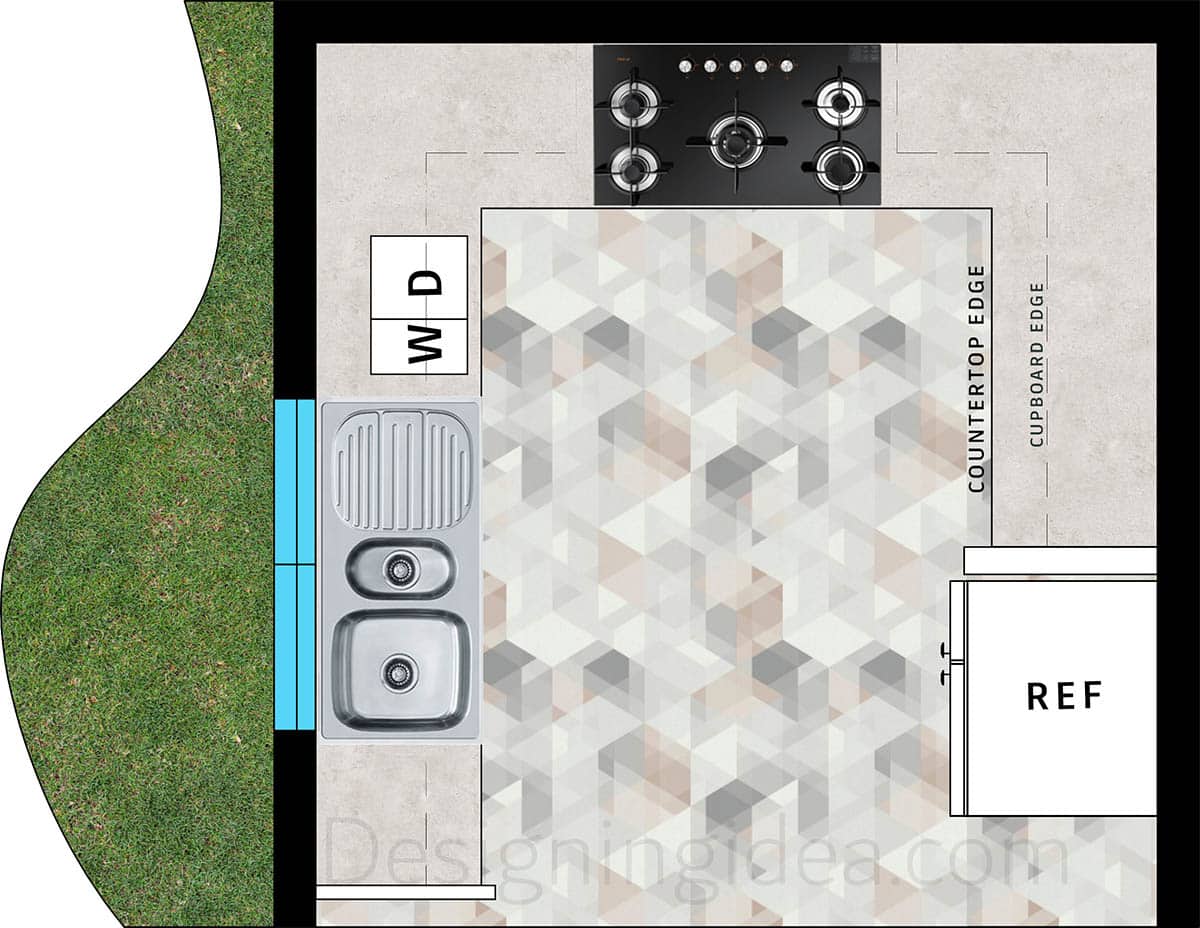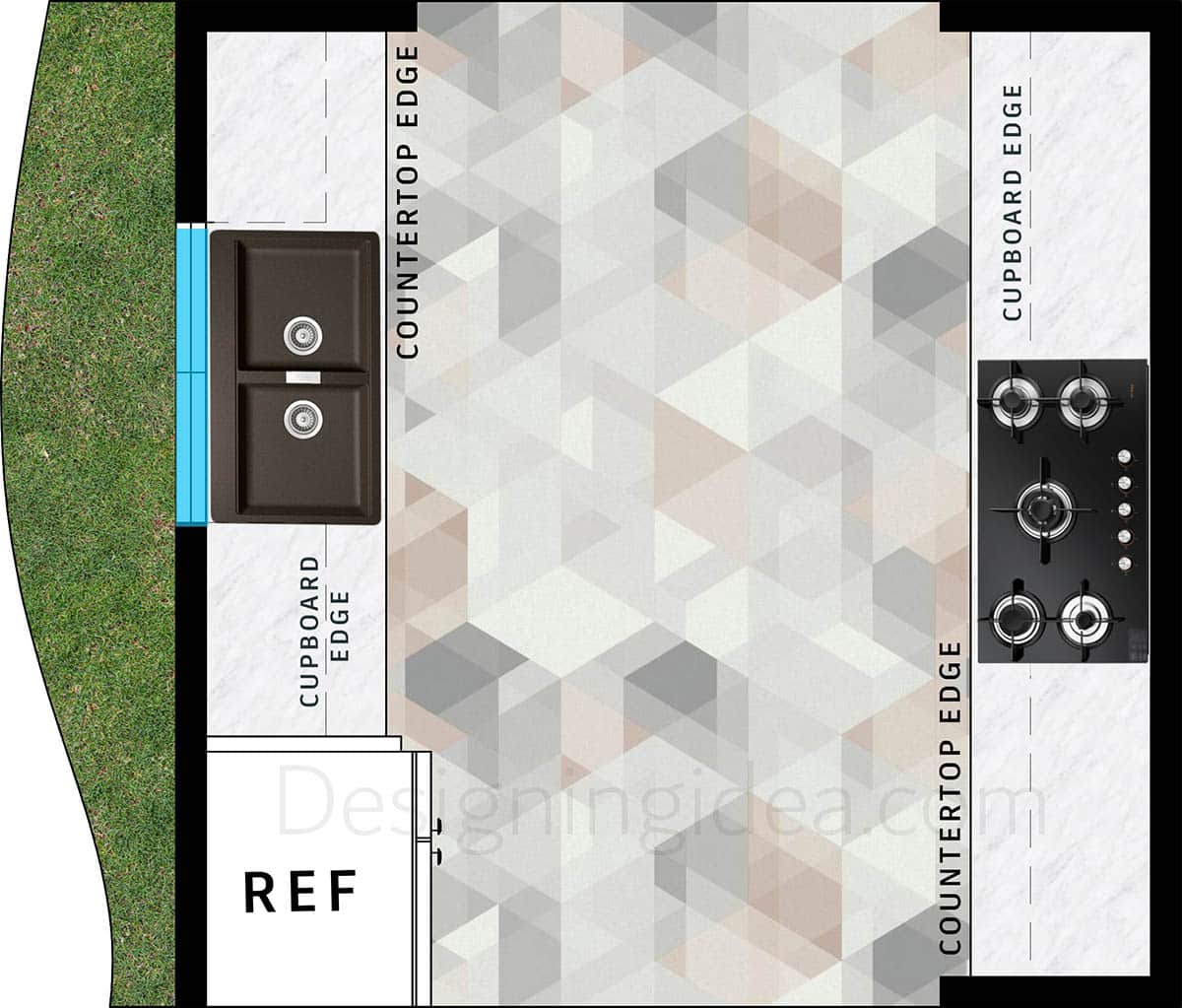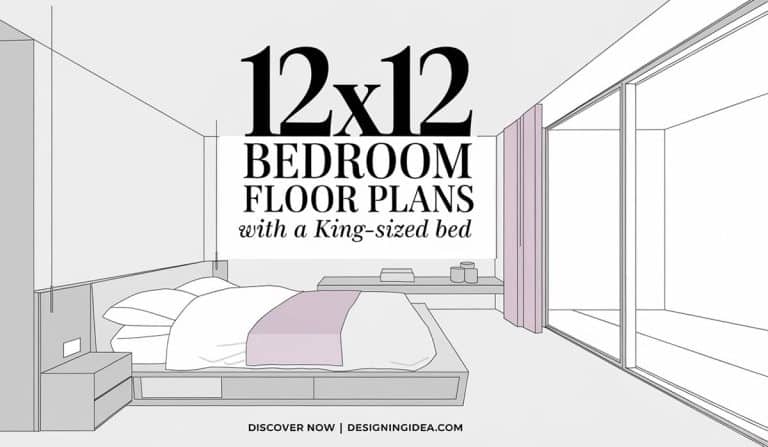7 Timeless 10×10 Kitchen Layout Ideas For The Perfect Floor Plan

In this comprehensive guide, we’ll explore seven time-tested kitchen layouts that demonstrate the remarkable versatility of the 10×10 space. From traditional U-shaped configurations that maximize storage to modern open-concept designs that create an airy feel, each layout offers unique advantages for different cooking styles and household needs. These carefully curated floor plans combine practical workflow considerations with contemporary design principles, ensuring your kitchen remains both beautiful and highly functional for years to come.
U-Shaped 10×10 Kitchen Layout
The u-shaped kitchen floor plan features countertops and cabinetry along three walls with a compact cooking and work tirangle that is effective for efficiency.
The U-shaped kitchen layout maximizes functionality within a 10×10 footprint by utilizing three walls for continuous workflow. This configuration creates extensive storage and workspace through strategic countertop and cabinet placement along each wall, forming the characteristic “U” shape that defines this design approach.
The layout’s effectiveness stems from its implementation of the work triangle principle. A dual-basin sink anchors the central workspace, while the four-burner stove and refrigerator are positioned at optimal distances to create efficient task zones. This arrangement minimizes movement between cooking stations, resulting in streamlined food preparation and cooking processes.

Space optimization extends beyond basic kitchen functions through the integration of a washer/dryer unit adjacent to the sink. This dual-purpose design accommodates multiple household tasks while maintaining dedicated cooking areas. The geometric patterned flooring provides visual definition to the space, while proximity to exterior areas allows for natural light and ventilation through strategic window placement.
Advantages of the U-shaped Layout:
- Counter configuration: Continuous surface along three walls.
- Appliance placement: Sink centrally located, stove and refrigerator at opposite ends.
- Additional features: Integrated washer/dryer unit.
- Storage solutions: Upper and lower cabinets throughout.
- Ventilation: External wall access for natural airflow.
L-shaped Layout
The L-shaped design is excellent for its open feel and uses two adjacent walls for counters and cabinets while leaving space for extra storage or a small table.
The L-shaped kitchen layout presents a sophisticated solution for maximizing functionality in a 10×10 space by strategically utilizing two adjacent walls. This configuration creates an open, flowing workspace while maintaining generous counter and storage capacity through its distinctive L-formation. The design’s inherent openness allows for unrestricted movement throughout the kitchen area, making it particularly suitable for small to medium-sized homes.

The layout’s efficiency stems from its thoughtful appliance placement and integrated storage solutions. Along the longer wall, a multi-burner stove serves as the primary cooking station, surrounded by ample counter space for food preparation. The shorter wall houses a dual-basin sink, positioned to maintain workspace flow while remaining accessible for cleaning tasks. A strategically placed refrigerator occupies the corner position, completing an efficient work triangle that minimizes unnecessary movement during meal preparation.
Storage capabilities are maximized through a comprehensive system of upper and lower cabinets running along both walls, with clearly defined countertop edges that establish distinct work zones. The design’s most distinctive feature is its incorporation of a small dining area, centered within the space. This intimate dining setup, featuring a light wooden table with seating for two, creates a seamless transition between cooking and dining zones while maintaining the kitchen’s open feel.
The L-shaped configuration utilizes only two walls, leaving one or two walls available for a pantry entrance if desired. This creates a natural flow between the main kitchen workspace and storage area without disrupting the primary work triangle.
Key Benefits of an L-shaped Design
- Optimized open flow – The L-shaped configuration maximizes usable floor space by concentrating work areas along two walls.
- Integrated dining solution – Allows for a dedicated dining area within the room.
- Enhanced storage efficiency – The L-configuration maximizes vertical storage potential along two walls while promoting an open feel.
- Strategic work triangle – The placement of major appliances – sink, stove, and refrigerator – creates an efficient work triangle that minimizes the amount of movement.
Galley-Style Layout
The galley style layout has two parallel walls with countertops and appliances on one or both sides for a streamlined workflow and an efficient floor plan for cooks.
The galley-style kitchen layout exemplifies efficient space utilization through its distinctive parallel counter design. This streamlined configuration positions two continuous countertop runs along opposing walls, creating a focused workspace that maximizes functionality within the 10×10 footprint. The linear arrangement establishes clear task zones while maintaining an organized flow throughout the space.

Workspace organization is achieved through strategic appliance placement and designated activity areas. The primary cleaning and preparation zone centers around the sink on one wall, with adjacent counter space providing ample room for food prep and cleaning tasks. The opposite wall houses the cooking zone, anchored by the stove, creating a natural separation of wet and dry preparation areas. This intentional division of tasks minimizes cross-traffic and promotes efficient workflow patterns. The refrigerator’s end-of-counter position provides convenient access while remaining outside the main work corridor, preventing disruption to the primary cooking and prep zones.
Storage efficiency is maximized through extensive cabinetry implementation along both walls. The parallel cabinet configuration offers substantial storage capacity through a combination of upper and lower units, ensuring kitchen essentials remain readily accessible while maintaining the space’s clean lines. This dual-wall storage approach effectively contains kitchen items without compromising the layout’s streamlined aesthetic or functional workspace requirements.
Key Benefits of a Galley Kitchen:
- Abundance of countertops – Maximized counter space through parallel wall utilization.
- Works for small floor plans – The parallel counter design optimizes every square inch by creating two efficient work zones
- Work triangle – Clearly defined work zones that separate wet and dry tasks.
- Efficient storage – Useful integration that maintains open workflow.
- Strategic appliance placement – The positioning minimizes cross-traffic for a good flow.
Peninsula Layout
A kitchen with a peninsula design has a countertop that juts out from one wall for additional counter space that can be used for a dine-in breakfast bar or for extra prep area.
The peninsula kitchen layout transforms a traditional 10×10 space through the strategic addition of an extended countertop that projects from one wall, creating a versatile workspace that bridges cooking and social zones. This distinctive peninsula feature incorporates seating for two, establishing a casual dining area that enhances the kitchen’s functionality without compromising its primary cooking purposes.

The layout’s effectiveness stems from its thoughtful organization of essential work zones. A centrally positioned sink along the main wall serves as the primary cleaning station, with generous counter space on either side facilitating food preparation and cleaning tasks. The cooking zone, anchored by the stove on the left wall, maintains clear sight lines while offering convenient counter space for meal preparation. Completing the efficient work triangle, the refrigerator occupies the right wall, creating an intuitive flow between storage, preparation, and cooking areas.
Storage solutions are integrated throughout the design through comprehensive cabinetry that maximizes vertical space along all walls. The peninsula itself contributes additional storage capacity through under-counter cabinets, effectively doubling its utility as both a workspace and storage solution. This strategic approach to storage ensures that kitchen essentials remain readily accessible while maintaining the space’s open feel.
Key Features of a Peninsula Design:
- Multifunctional – The peninsula that serves as both prep space and casual dining area.
- Efficient work triangle – This configuration that optimizes movement between key appliances.
- Comprehensive storage integration – This helps maintain clean sight lines across the space.
- Balanced design – The floor plan facilitates both cooking efficiency and social interaction.
Kitchen Island Centered Layout
An island-centered design can create additional prep space and storage that balances workspace and traffic circulation.
The island-centered kitchen layout optimizes a 10×10 space through strategic placement of a central workspace that serves as both functional hub and social focal point. This compact yet versatile island incorporates seating for one, creating a flexible zone that transitions seamlessly between food preparation, casual dining, and social interaction. The island’s central positioning establishes natural circulation patterns while maintaining clear sightlines throughout the space.

The layout achieves optimal functionality through calculated appliance placement along the perimeter walls. A well-proportioned sink station occupies the left wall, complete with adjacent counter space that facilitates both food preparation and cleanup tasks. The cooking zone, anchored by the stove along the top wall, benefits from flanking counter spaces that provide convenient staging areas for both ingredients and finished dishes. The refrigerator’s strategic placement at the bottom left creates an efficient work triangle, minimizing movement between essential task areas while maintaining open circulation around the central island.
Storage integration demonstrates particular attention to spatial efficiency through comprehensive cabinetry placement along the perimeter walls. The island itself augments this storage capacity through integrated under-counter cabinets, effectively multiplying the kitchen’s organizational potential while maintaining its clean, modern aesthetic.
Essential Benefits of an Island-Centered Design:
- Multifunctional – A central island supports diverse kitchen activities.
- Strategic appliance positioning – Positioning appliances in the island creates efficient workflow patterns.
- Maximized storage capacity – By using dual-level cabinet integration, there is extra storage space.
- Open circulation design – The floor plan facilitates movement and social interaction
Open-Concept Kitchen Plan
The open-concept kitchen floor plan connects seamlessly with the dining or living space at the expense of upper cabinetry to promote a more spacious feel.
The open-concept kitchen layout revolutionizes the traditional 10×10 footprint by seamlessly blending cooking and dining zones into a cohesive living space. The kitchen area maintains efficiency through strategic appliance placement, with a well-positioned sink along the left wall providing dedicated space for cleaning and preparation tasks. The cooking zone, anchored by the stove on the top wall, benefits from generous counter space on both sides, creating natural workflow patterns that support multiple cooking stages.

Storage solutions demonstrate careful consideration of spatial dynamics through comprehensive cabinetry integration along the kitchen walls. These storage elements maintain clean sight lines while ensuring cooking essentials remain readily accessible, striking a crucial balance between functionality and aesthetic appeal. The thoughtfully defined countertop edges establish clear work zones without creating visual barriers that might disrupt the space’s open flow.
The dining area’s integration serves as a cornerstone of this design’s success, featuring a generously proportioned rectangular table that accommodates six people comfortably. This intentional proximity between kitchen and dining zones facilitates effortless transitions from food preparation to serving, while maintaining open sight lines that encourage social interaction throughout meal preparation and dining activities.
Primary Benefits of an Open-Concept Kitchen Plan:
- Seamless integration of cooking and dining functions
- Easy accessibility for appliances – Strategic appliance placement that optimizes workflow
- Good balance between functionality and design – Comprehensive storage solutions that maintain open sight lines
- Excellent for entertaining – Enhanced social connectivity through unobstructed spatial flow
Corner Sink Placement Layout
The kitchen with corner sink placement has an efficient use of space that open countertop on either side for meal prep. This plan works well with an L or U-shape design.
The corner sink kitchen layout exemplifies intelligent space utilization through its innovative approach to corner placement, transforming what is often an awkward area into a highly functional workspace hub. By positioning the sink at the intersection of two walls, this design creates a natural focal point that maximizes counter space while establishing efficient workflow patterns. The corner placement generates two adjacent work surfaces that facilitate both food preparation and cleanup tasks, effectively doubling the utility of this traditionally challenging space.

Workspace organization flows naturally from this corner anchor point through strategic counter placement and appliance positioning. A continuous countertop extends along both the left and right walls, creating uninterrupted work surfaces that maintain clear sight lines throughout the kitchen. The stove’s placement along the right wall establishes a dedicated cooking zone with convenient prep space, while the refrigerator’s position on the top wall completes a highly efficient work triangle that minimizes movement between key task areas.
Storage integration demonstrates particular attention to spatial efficiency through comprehensive under-counter cabinet placement. This approach maximizes storage capacity while maintaining the kitchen’s clean lines and open feel, ensuring that essential items remain readily accessible without creating visual clutter. The continuous cabinet configuration takes full advantage of available wall space, providing ample storage solutions that support the kitchen’s functional requirements.
Essential Benefits of a Corner Sink Layout:
- Functionality – An optimized corner utilization maximizes the counter workspace.
- Appliance placement – Strategic appliance locations create an efficient workflow.
- Visibility – Comprehensive storage solutions maintain clean sight lines.
- Versatile design – The balanced configuration supports multiple simultaneous tasks.
For some slightly smaller plans, take a look at our 8ft by 10ft kitchens here.






